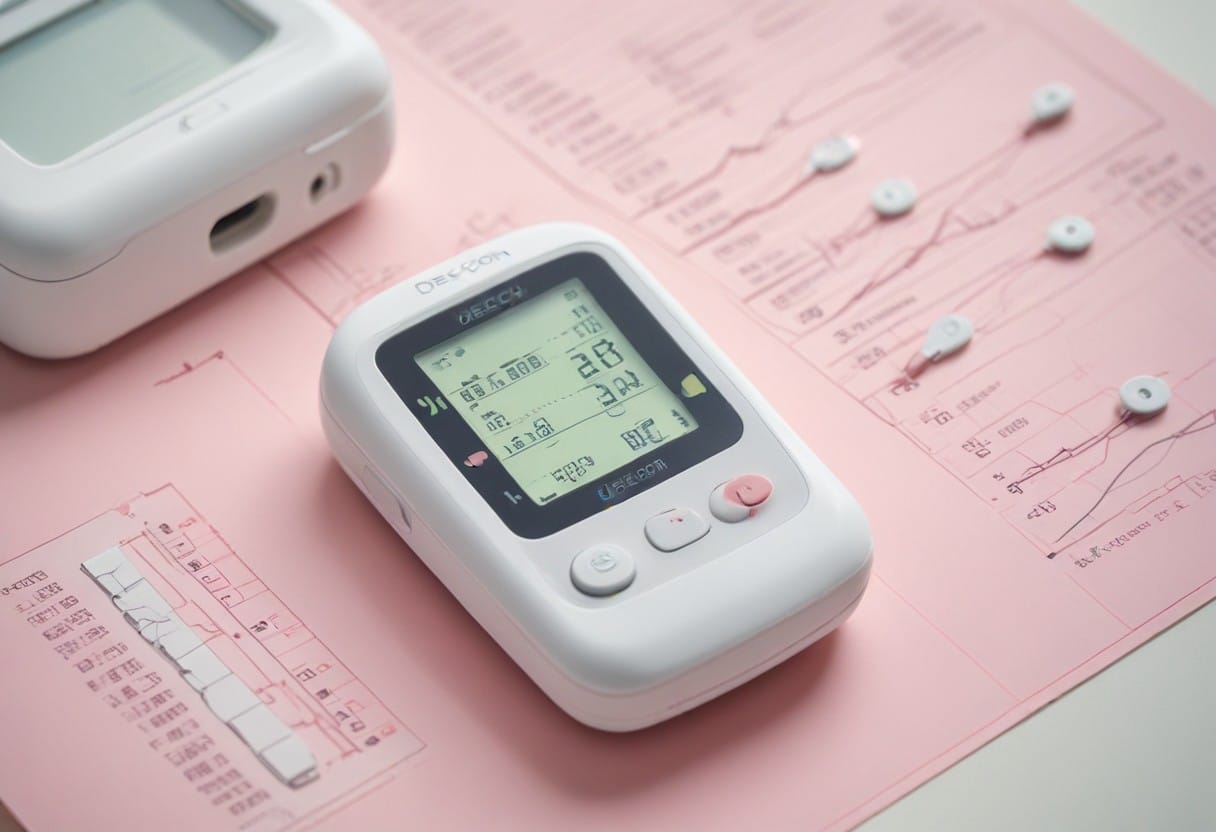Being pregnant is a significant life change affecting your body and mind. When you are expecting a baby, looking for ways to stay healthy and feel good during this important time is expected. One technique gaining popularity among pregnant individuals is forward-leaning inversion. This article will explore the techniques, benefits, and safety considerations of forward-leaning inversion during pregnancy, helping you make informed choices for a healthy and comfortable pregnancy.
During pregnancy, a woman often assumes a forward-leaning inversion position. This position places her upper body lower than her hips, usually with the aid of a chair or cushions, and allows her belly to hang freely. People believe that this gentle inversion can optimize the position of the fetus and increase the mother’s comfort during pregnancy and labor.
Leaning forward in an inverted position is a good practice during pregnancy for a few reasons. First, it is believed to help the baby get into the optimal position for birth, with the head down (vertex) or facing forward (anterior). Forward-leaning inversion can make labor and delivery easier. Additionally, this position may take pressure off the cervix and pelvic floor muscles, potentially reducing the risk of complications like the baby being positioned incorrectly or facing the wrong way.
In the forward-leaning inversion technique, a woman assumes the position for a few minutes. Forward-leaning inversion allows gravity to encourage the baby into a favorable position gently. To perform this technique under supervision and with caution, particularly for those with high-risk pregnancies or specific medical conditions.
Understanding Forward Leaning Inversion in Pregnancy
The forward-leaning inversion position during pregnancy involves the pregnant woman positioning her upper body lower than her hips, which allows her belly to hang freely. This forward-leaning inversion position has multiple benefits for the pregnant body. These benefits include optimizing fetal positioning, enhancing maternal comfort, and potentially aiding labor preparation. However, it’s always essential to consult a healthcare professional before trying new techniques during pregnancy. Safety should always be the priority.
To begin with, some believe that forward-leaning inversion helps the baby migrate into an advantageous birth position, such as head down (vertex) or anterior. These positions are important because babies often have smoother labor and delivery processes. The forward-leaning inversion may lower the chances of a posterior presentation by giving the baby more room to move and settle into a good position. In a posterior presentation, the baby’s head faces upward, sometimes resulting in longer, more challenging labor.
The second potential benefit of the forward-leaning inversion position during pregnancy is that it may help release tension in the uterine ligaments. During pregnancy, the uterus is supported by ligaments that can become tight and strained as the baby grows. By allowing the uterus to hang freely in an inverted position, these ligaments can relax and release some of this tension, potentially reducing discomfort for the mother.
If you plan to try leaning forward positions during pregnancy, it’s crucial to do so carefully and with advice from your doctor or midwife. Some basic tips include:
- Avoid the practice if you are dealing with particular health issues or difficulties related to your pregnancy, like elevated blood pressure levels, irregularities with the placenta, or if you have previously experienced premature labor contractions before your due date.
- Proper support, such as a chair or cushions, ensures stability and comfort during the inversion.
- Starting with gentle inversions and gradually increasing the duration as tolerated.
- Pay close attention to the signals from your body and immediately discontinue this inverted leaning if it causes any unpleasant sensations, feelings of lightheadedness, or any other negative impacts.
- Avoid abrupt movements or changes in position during and after the inversion to prevent falls or injury.
Benefits for Pregnancy and Labor
Forward-leaning inversion during pregnancy offers several benefits that can contribute to a more comfortable pregnancy and potentially smoother labor and delivery process.
Relieving Pelvic Pain:
As the baby grows during pregnancy, the expanding uterus applies force on the pelvic floor muscles and ligaments, resulting in soreness and pain. Leaning forward in an inverted position enables the uterus to hang freely, taking the pressure off and diminishing pelvic pain. Moreover, the gentle stretching of the pelvic muscles may help reduce tightness and improve blood circulation to that region, further alleviating discomfort.
Encouraging Optimal Fetal Positioning:
The baby’s location in the womb considerably impacts the ease and progress of labor. Forward-leaning inversion stimulates the baby to go into a head-down (vertex) position, regarded as the best position for birth. This positioning can help ensure the baby’s head is engaged in the pelvis, leading to a more efficient labor process.
Supporting Labor Progress:
The forward-leaning inverted stance can aid the advancement of labor through multiple mechanisms. Prompting the baby to settle into an ideal position enables the baby’s head to exert pressure on the cervix, thereby facilitating its dilation. Furthermore, the gravitational forces acting upon the uterus may promote the baby’s descent into the birth canal, further expediting labor.
Enhancing Maternal Comfort:
Pregnancy can be physically demanding, especially in the later stages. Forward-leaning inversion provides a change in position that can help alleviate some of the discomforts associated with late pregnancy, such as back pain, sciatica, and digestive issues. The relaxation induced by this practice can also improve overall comfort levels.
Reducing Stress:
Being pregnant can be very stressful on the body and mind. Leaning forward in an inverted position has a calming effect. It helps you relax and reduces feelings of stress and anxiety. The deep breathing and focus required during this practice can also help pregnant individuals connect with their bodies and growing babies, fostering a sense of well-being.
Potentially Shortening Labor Duration:
While individual experiences may vary, some studies suggest that optimal fetal positioning achieved through practices like forward-leaning inversion can lead to shorter labor durations. Promoting an efficient labor process may help reduce some individuals’ overall labor length.
Integrating the forward-leaning inverted position into a prenatal wellness regimen can confer physical and emotional advantages, contributing to a more comfortable gestational period and facilitating a smoother labor process. Nonetheless, it is imperative to consult with a healthcare professional before initiating any novel practice during pregnancy to guarantee safety and appropriateness based on individual circumstances.

Techniques and Variations
Performing forward-leaning inversion during pregnancy can be a simple yet effective practice. Here’s a step-by-step guide:
- Choosing a Comfortable Position: Depending on the stage of pregnancy and one’s level of comfort, there are several options for the beginning position of the forward-leaning inversion. Kneeling on a supple surface, such as a yoga mat or carpet, could be more comfortable for certain people. Some might want to use a sofa or chair to provide extra support.
- Adjusting Body Position: Once in the starting position, slowly lean forward, allowing your belly to hang freely between your thighs. To prevent undue tension on your lower back, maintain a straight back. For extra support, place your hands on the ground or the chair in front of you.
- Breathing and Relaxation: When leaning forward during pregnancy, concentrate on inhaling and exhaling slowly and deeply. Controlled breathing can help calm your mind and relax your body, promoting a sense of tranquillity and comfort. Release any tension in your pelvic area and lower back as you breathe.
- Duration of the Inversion: How long you stay in the inverted leaning position can vary based on your comfort level. Start by holding the forward-leaning pose for short periods, like one or two minutes at a time. As you get used to it, you can gradually increase how long you stay in the position. However, if you experience any pain or lightheadedness, stop the exercise immediately.
- Modifications for Different Stages of Pregnancy: As your belly grows bigger during pregnancy, you may need to modify this forward-leaning inversion. You can widen your stance to allow your belly to hang freely or use props like cushions or yoga blocks to provide additional support and comfort.
- Addressing Specific Fetal Positions: If your healthcare provider has identified a specific fetal position, such as a posterior position (head up, facing your abdomen), you can modify the forward-leaning inversion to encourage the baby to turn. Use an inclined surface, such as a yoga wedge or stack of pillows, to create a gentle incline that enables the baby to move into a more favorable position.
- Advanced Tips and Variations: Some advanced variations of forward-leaning inversion include incorporating gentle rocking motions or having your partner provide gentle pressure on your lower back or hips. These techniques can help relax the pelvic muscles and encourage optimal fetal positioning.
Modifications for Different Stages of Pregnancy and Fetal Positions:
Early Pregnancy: In the early stages of pregnancy, you may find it more comfortable to use a cushion or yoga block to support your head and chest while in the forward-leaning position.
Late Pregnancy: As your pregnancy advances, you may require a wider stance to make room for your expanding abdomen. You can also utilize a chair for additional support and position a cushion beneath your knees to enhance your comfort level during this inverted leaning position.
Posterior Position: If your baby is in a posterior position (head up, facing your abdomen), you can try forward-leaning inversion on an inclined surface, such as a yoga wedge or stack of pillows, to encourage the baby to turn.
Advanced Tips and Variations:
- Rocking Motion: In the forward-leaning position, gently rock your hips from side to side or back and forth to help relax the pelvic muscles and encourage the baby to settle in a favorable position.
- Partner Assistance: Your partner can gently press your lower back or hips. At the same time, you’re in the forward-leaning position to provide additional support and encouragement for the baby to move into position.
- Breathing Techniques: Incorporate deep breathing techniques, such as belly or paced breathing, to enhance relaxation and promote optimal positioning for you and your baby.
- Visualization: While inversion, visualization can be a powerful tool during pregnancy. While in the forward-leaning inversion position, you can visualize your baby in the optimal position for birth, such as head down and facing your spine. These visuals can create a positive mindset and encourage the baby to move into that position. It’s like a form of gentle communication between you and your baby. But always speak with your doctor before attempting any new methods while expecting. Comfort and safety ought to come first at all times.
It is crucial to pay heed to the signals your body conveys and seek counsel from your healthcare professional before attempting any advanced modifications of the forward-leaning inverted stance, particularly if you are contending with any pre-existing medical conditions or pregnancy-related complications.
Safety Precautions and Variations
Forward-leaning inversion can be a safe practice for many pregnant individuals, but it’s essential to follow safety precautions and be aware of contraindications. Here are some guidelines:
Safety Precautions:
Consult with a Healthcare Provider: Before trying any new exercise routine or technique while pregnant, it’s essential to discuss it with your doctor or midwife first. They can evaluate if it poses any risks to you or your developing baby and provide personalized advice on proceeding safely.
Use Proper Support: When performing forward-leaning inversion, use a chair, cushion, or yoga block for support to prevent falls or injuries.
Avoid Abrupt Movements: Move slowly and mindfully when transitioning into and out of the inversion to prevent dizziness or discomfort.
Listen to Your Body: Stop immediately if you experience pain, discomfort, or dizziness. This practice should be comfortable and relaxing.
Limit Duration: Start with short durations (1-2 minutes) and gradually increase as tolerated, but avoid prolonged inversions.
Stay Hydrated: Ensure you drink plenty amounts of water both before and following the practice of the forward-leaning inverted position to keep your body adequately hydrated.
Contraindications:
- High Blood Pressure: Individuals with uncontrolled high blood pressure or preeclampsia should avoid inversion poses.
- Placental Abnormalities: Steer clear of inverted leaning positions if you have a condition called placenta previa or any other irregularities with the placenta.
- Risk of Preterm Labor: If there is a chance you could go into labor too early or if you have given birth prematurely before, do not attempt inverted leaning poses.
- Heart Conditions: Individuals with heart conditions or other cardiovascular issues should avoid inversion poses.
- Multiples: If you are carrying twins or multiples, avoid inversion poses due to the increased risk of complications.
Addressing Common Concerns and Myths:
Myth 1: Inversions Can Cause the Umbilical Cord to Wrap Around the Baby’s Neck (Nuchal Cord): No evidence suggests that inversion increases the risk of the nuchal cord. In some cases, the umbilical cord may coil around the baby’s neck, but this occurrence is typically not triggered by the positions assumed by the mother.
Myth 2: Inversions Can Cause the Baby to Become Dizzy or Disoriented: Babies are protected by the amniotic fluid and are not affected by maternal movements or positions in this way.
Myth 3: Inversions Can Cause Miscarriage: There is no evidence to suggest that inversion poses an increase in the risk of miscarriage in a healthy pregnancy. However, it is imperative to remain attentive to the signals conveyed by your body and abstain from assuming any postures that induce discomfort or undue strain.
Overall, forward-leaning inversion can be beneficial safely and cautiously during pregnancy. Listening to your body’s signals is crucial. Before attempting any unfamiliar poses or exercises, consult your doctor or midwife for approval. If something feels uncomfortable or risky, don’t do it. Your well-being and the baby’s safety should be the top priorities.
Incorporating Forward Leaning Inversion into Pregnancy Wellness
Integrating forward-leaning inversion into a pregnancy wellness routine can be a beneficial practice. Some of the tips are:
Frequency and Duration: Start slowly by leaning forward in this inverted position 2-3 times weekly for 1-2 minutes. As it starts to feel more comfortable, you can gradually increase how frequently you do it and for how long.
Complementary Exercises: Combine forward-leaning inversion with other pregnancy-safe exercises, such as prenatal yoga, gentle stretching, and pelvic floor exercises, to support overall pregnancy wellness.
Listen to Your Body: Pay close attention to how you feel while in the forward-leaning position, as well as after. If you experience any strain, pain, or discomfort at any point, stop the exercise immediately. Don’t hesitate to consult your doctor, especially if the unpleasant sensations persist.
Modify as Needed: As your belly grows, you may need to adjust this leaning position to make room. Use pillows or other props to support yourself and change the leaning angle as required.
Breathing and Relaxation: Incorporate deep breathing and relaxation techniques into your inversion practice to enhance calming and stress-relieving effects.
Consult with a Healthcare Provider: Before trying any new exercise or wellness activity during pregnancy, talk to your doctor or midwife first to ensure it is safe for you and your baby.
The potential impact of forward-leaning inversion on maternal well-being, fetal positioning, and birth outcomes can be positive. By promoting relaxation, relieving pelvic pressure, and encouraging optimal fetal positioning, forward-leaning inversion may contribute to a more comfortable pregnancy and potentially smoother labor and delivery process. However, it’s advisable to check with your healthcare provider first to ensure this approach is appropriate for your specific situation. They can provide personalized guidance based on your medical history and current pregnancy status.
Conclusion
In conclusion, forward-leaning inversion during pregnancy offers several potential benefits, including relieving pelvic pain, encouraging optimal fetal positioning, and supporting labor progress. When practicing forward-leaning inversion, following safety precautions, such as consulting with a healthcare provider, using proper support, and listening to your body is essential.
Pregnant individuals interested in incorporating forward-leaning inversion into their pregnancy wellness routine should start gradually, listen to their body, and consult healthcare providers and prenatal yoga instructors for personalized guidance. By approaching this practice with caution and mindfulness, pregnant individuals can potentially experience increased comfort and relaxation during pregnancy and support optimal positioning for labor and delivery.




